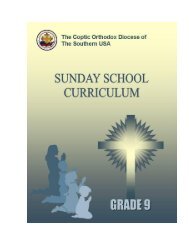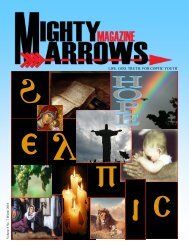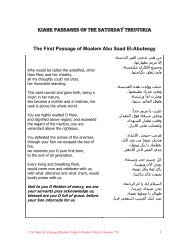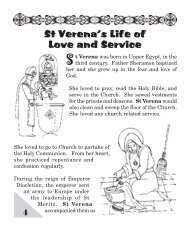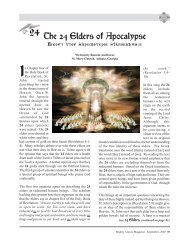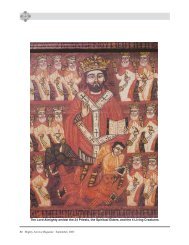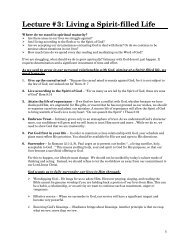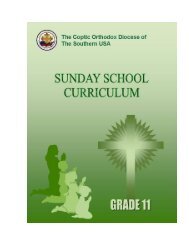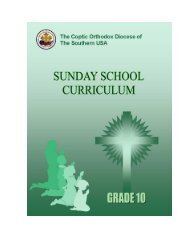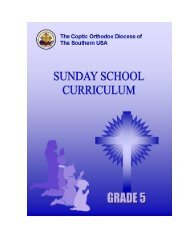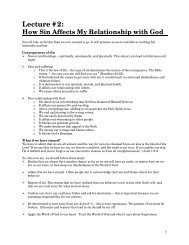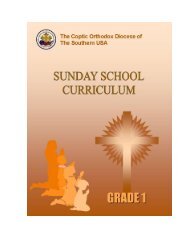Grade 12 - Coptic Orthodox Diocese of the Southern United States
Grade 12 - Coptic Orthodox Diocese of the Southern United States
Grade 12 - Coptic Orthodox Diocese of the Southern United States
Create successful ePaper yourself
Turn your PDF publications into a flip-book with our unique Google optimized e-Paper software.
Sunday School Curriculum <strong>Grade</strong> <strong>12</strong><br />
takes place, starting from <strong>the</strong> south <strong>of</strong> <strong>the</strong> church nave, during which a hymn <strong>of</strong> rebuking<br />
Judas <strong>the</strong> betrayer is chanted as a warning to us not to fall like him.<br />
7 Thomas Sunday: This is <strong>the</strong> Sunday that follows <strong>the</strong> feast <strong>of</strong> <strong>the</strong> Resurrection; in it those<br />
who believe without seeing are blessed, so that all might live in faith through <strong>the</strong> internal<br />
touch <strong>of</strong> <strong>the</strong> Savior‘s wounds (John 20:29).<br />
C. The Monthly Feasts<br />
The believers joyfully celebrate <strong>the</strong> commemoration <strong>of</strong> <strong>the</strong> Annunciation, Nativity and<br />
Resurrection <strong>of</strong> Christ on <strong>the</strong> 29 th <strong>of</strong> every <strong>Coptic</strong> month (except during <strong>the</strong> Great Lent).<br />
In addition, <strong>the</strong> commemoration <strong>of</strong> St. Mary is celebrated on <strong>the</strong> 21 st <strong>of</strong> each <strong>Coptic</strong> month while<br />
<strong>the</strong> feast <strong>of</strong> <strong>the</strong> Archangel Michael is celebrated on <strong>the</strong> l2 th <strong>of</strong> every month.<br />
D. The Weekly Feasts<br />
Every Sunday stands as a true Sabbath (rest), in which we find our rest in <strong>the</strong> Resurrection <strong>of</strong><br />
Christ. There is no strict abstention from food on Sundays after <strong>the</strong> celebration <strong>of</strong> <strong>the</strong> Eucharist, even<br />
during Great Lent. In addition, since <strong>the</strong> Lord rested from His work on <strong>the</strong> Sabbath (Saturday), we<br />
also avoid strict abstinence on this day.<br />
E. Feasts <strong>of</strong> <strong>the</strong> Saints<br />
There is a daily feast, so that <strong>the</strong> believers may live in perpetual joy and in communion with <strong>the</strong><br />
saints. In addition, <strong>the</strong>re are o<strong>the</strong>r special fasts and occasions:<br />
The Feasts <strong>of</strong> St. Mary: The <strong>Coptic</strong> Church venerates St. Mary as <strong>the</strong> ―Theotokos,‖ i.e., <strong>the</strong><br />
Mo<strong>the</strong>r <strong>of</strong> God, whom <strong>the</strong> Divine Grace chose to bear <strong>the</strong> Word <strong>of</strong> God in her womb by <strong>the</strong><br />
Holy Spirit (Luke 1:35). Since she is considered to be <strong>the</strong> exemplary member in <strong>the</strong> church,<br />
and <strong>the</strong> interceding mo<strong>the</strong>r on behalf <strong>of</strong> her spiritual children, she is exalted above heavenly<br />
and earthly creatures. Therefore, <strong>the</strong> church does not cease glorifying (blessing) her and<br />
celebrating her feasts in order that we imitate her and ask for her intercessions on our behalf<br />
Her main feasts are:<br />
a) The annunciation <strong>of</strong> her birth (Mesra 7, c. August 13);<br />
b) Her Nativity (Bashans 1, c. May 9);<br />
c) Her Presentation into <strong>the</strong> Temple (Kiahk 3, c. December <strong>12</strong>);<br />
d) Her Repose (Tuba 21, c. January 29);<br />
e) The Assumption <strong>of</strong> her body (Mesra 16, c. August 22)<br />
f) Her apparition over <strong>the</strong> Church <strong>of</strong> Zeitoun (Paramhat 24, C. April 2);<br />
g) The consecration <strong>of</strong> her first Church in Philippi (Paona 21, c. June 28)<br />
The Apostles‟ Feast (Abib 5, c. July <strong>12</strong>): This is <strong>the</strong> feast <strong>of</strong> martyrdom <strong>of</strong> <strong>the</strong> Apostles Peter<br />
and Paul. It is preceded by a fasting period, which starts on <strong>the</strong> day following <strong>the</strong> Feast <strong>of</strong> <strong>the</strong><br />
Pentecost. In this feast, <strong>the</strong> liturgy <strong>of</strong> blessing <strong>the</strong> water takes place, in which <strong>the</strong> priest<br />
washes <strong>the</strong> feet <strong>of</strong> his people commemorating what <strong>the</strong> Lord did for His disciples. Thus, <strong>the</strong><br />
priest remembers that he is a servant who washes <strong>the</strong> feet <strong>of</strong> <strong>the</strong> people <strong>of</strong> God and not a man<br />
<strong>of</strong> authority.<br />
The Nayrouz Feast (1 st <strong>of</strong> Tute, c. September 11): The word ―Nayrouz‖ is Persian word,<br />
meaning ―<strong>the</strong> beginning <strong>of</strong> <strong>the</strong> year.‖ The Egyptian calendar goes back to 4240 BC. Copts<br />
restarted <strong>the</strong> calendar with <strong>the</strong> beginning <strong>of</strong> Dioc1etian‘s reign in AD 284, to commemorate<br />
160 PENTECOST PERIOD



